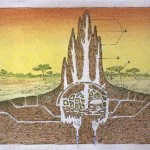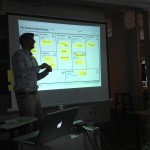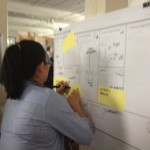Apr02
Andrea Meyer
Point: Get quick wins by encouraging small experiments throughout the organization. They’re fast, inexpensive, and reduce the fear of failure.
Story: One of the biggest obstacles to innovation is fear of failure. Rarely do people want to bet their careers or companies on what might — or might not — be the next big thing. But fear of failure becomes a self-imposed obstacle to success.
As Amazon’s CEO Jeff Bezos says, “Innovation is part and parcel with going down blind alleys. You can’t have one without the other. But every once in a while, you go down an alley and it opens up into this huge, broad avenue. And that’s so satisfying and, from a shareholder’s point of view, so successful, that it makes going down blind alleys worthwhile.”
The key twist isn’t to avoid failure but to avoid high costs from failure. To reduce those costs, institute and encourage ongoing little experiments throughout your company. For example, Google does this by testing more than 5000 software changes a year. Amazon does it by continuous A/B testing. And CEO Scott Cook made experiments common practice at Intuit. In Cook’s experience, 89% of experiments don’t lead to a breakthrough or even to an improvement, but that doesn’t make them a “failure” — the experiments simply provide data on what doesn’t work.
These little bets cost little in terms of time and money. They don’t require weeks of planning; rather, they’re tweaks to an idea that can lead to eventual, substantive breakthroughs. Ever hear of a company called Odeo? Most people haven’t, because Odeo was a small podcasting company of little distinction until its CEO, Evan Williams, gave employee Jack Dorsey two weeks to develop his idea of a short messaging system. That quick prototype developed into Twitter.
Action
- Don’t use uncertainty of success as a filter — the more you don’t know about your chances, the more you can learn by trying.
- Do consider how you might inexpensively look down a possible avenue to see where it leads. You might use a A/B testing, co-innovation with a lead customer, or a quick minimum-viable prototype.
- Test fast, test often, but pay attention to the results, especially if the unexpected happens.
- Learn what you can from any failures — not just that the idea failed, but why it failed and what it says about your customers, your markets, or your business environment.
- Use each test of a new avenue to scout for other avenues. Even a blind alley can have a side-passage that leads somewhere wondrous.
For more information:
Dave Gray, The Connected Company
Bloomberg BusinessWeek, “Jeff Bezos: ‘Blind-Alley’ Explorer.”
Peter Sims, Little Bets and “What are Little Bets?“
Growth, How-to, Innovation, New Product Development, Opportunity, Productivity
Mar06
Andrea Meyer
Point: If you’re stuck on how to solve a problem, see if nature has already solved that problem.
Story: Nature has already solved many challenges; the best solutions have survived and improved through evolution.
Consider this example: termite mounds such as those of the Macrotermes michaelseni exist in African environments where the external temperature varies from 35°F at night to 104°F during the day. The living areas inside the termite mounds, however, maintain a constant internal temperature within one degree of 87 °F, day and night. Millions of years of evolution perfected the termites’ construction habits so that their mounds’ passive solar design and networks of air conduits create a self-cooling ventilation system.
How can humans put this termite-inspired solution to use? Architect Mick Pearce collaborated with engineers at Arup Associates to design a mid-rise building in Harare, Zimbabwe, called Eastgate, that has no air-conditioning, yet stays cool. The Eastgate Center is the largest office and shopping complex in Zimbabwe, but it uses only only 10% of the energy of a conventional building its size. Not only is this good for the environment, but it lowers costs for building occupants. Eastgate occupants pay 20% lower rents than do occupants in nearby buildings pay.
How did Pearce design this building? He looked a 3D digital scans of termite mounds, manipulating them in computer models to understand how the tunnel system works to exchange gases and regulate temperature and humidity. It turns out that the termite mounds operate on a system of convection currents that draw air at the lower part of the mound down to the bottom and then exhaust heated air to the top. The termites open and close ducts by digging new vents and plugging up old ones. At Eastgate, Pearce installed electronically-controlled fans on the first floor to suck in outside air and then push it up along a central spine, venting it through chimneys at the top.
computer models to understand how the tunnel system works to exchange gases and regulate temperature and humidity. It turns out that the termite mounds operate on a system of convection currents that draw air at the lower part of the mound down to the bottom and then exhaust heated air to the top. The termites open and close ducts by digging new vents and plugging up old ones. At Eastgate, Pearce installed electronically-controlled fans on the first floor to suck in outside air and then push it up along a central spine, venting it through chimneys at the top.
Action
- If you have a problem to solve, think about the plants and animals that may have had the similar problem. Look to sites like AskNature.org or the Biomimicry 3.8 Institute
- Study nature for inspirations and ideas that you can adapt
- If you don’t have time to do this yourself, consider holding an innovation contest with InnoCentive, NineSigma, or Yet2.com to solicit ideas from biologists, oceanographers, etc. who could apply knowledge from the biological world to tackle your problem.
Sources:
Janine Beyrus, Biomimicry: Innovation Inspired by Nature, chapter 1
Biomimicry 3.8 Institute
Abigail Doan, Green Building in Zimbabwe Modeled After Termite Mounds | Inhabitat – Sustainable Design Innovation, Eco Architecture, Green Building
Case study, How-to, Innovation
Oct03
Andrea Meyer
Point: Create new business models using a visual, collaborative tool like Alex Osterwalder’s Business Model Canvas.
Story: Business models are complex, which makes them hard to talk about. A business has many interrelated moving pieces. It’s easy for you and your team to miss something when creating one. And with so much complexity and so many possibilities, it’s easy misunderstand each other when we try to invent new business models.
Luckily, there’s a solution. Alex Osterwalder’s Business Model Canvas is a visual tool that helps structure our thinking about business models.
At Osterwalder’s Business Model workshop at BIF8 last week, I saw the power of his Business Model Canvas firsthand. Osterwalder outlined the Canvas method and gave the group the assignment to generate a business model for a specific startup. Small groups clustered around their canvas and the room buzzed with discussion and the squeak of markers as participants took turns sketching out ideas. As we worked, I was struck by three key features of Osterwalder’s approach.
The first key feature was that Osterwalder encouraged sketching, not just making lists of words. “Any problem can be made clearer with a picture,” he said. The visual artifact lets people react to something concrete. To encourage people who think they can’t draw, Osterwalder pointed out that people can interpret a stick figure more easily than an abstract concept. “Drawing something, however badly, makes an abstract concept concrete, giving people an opportunity to react to it,” Osterwalder said. Visual thinking helps with understanding, dialogue, exploration and communication.
The second key feature was that Alex had us make our sketches and notes on Post-It® notes. We then stuck these to the Canvas. The key part was that then we could move the notes around as we figured out where on the canvas they belonged. “Post-It® notes are like containers of ideas,” Osterwalder said, that can be easily picked up and moved around. Thus, we could reconfigure our ideas as we refined them.
The third key feature was that the Canvas with its Post-It® notes ensures you don’t miss an important area. Because business models are so complex, with many interlocking pieces, it’s hard to hold all the pieces in memory and see their interactions and dependencies. The Canvas helps everyone see all the pieces and confirm that they work together and make sense. People can use different colors of Post-It notes for different business models, which lets them compare alternate models on the same Canvas. This side-by-side comparison can help to then pick the most promising model to test.
Action:
- If you’re working in a group, print the Canvas in large format (we used 3′ x 4′ at the workshop).
- Most people start on the righthand side of the Canvas, which is the customer side of your business model. It has the “Customer Segments,” “Channels,” and “Customer Relationships” areas. The lefthand side defines the infrastructure of the business with “Key Activities,” “Key Resources,” and “Partner Networks.” A central “Value Proposition” sits between the infrastructure areas that deliver on the proposition and the customer areas that receive the value. Finally, the “Cost Structure” and “Revenue Streams” areas on the bottom sit respectively under the infrastructure and customer sides of the canvas to define the financial side of the model.
- Play with different kinds of models. For example, Nestlé (in its Nespresso business) tested a model in which Nestlé sold its espresso machine through retail but sold the individual “pods” of coffee directly to consumers. Going direct was new to Nestlé but proved to be very lucrative because Nestle didn’t have to share revenue with the retailer.
- Keep interdependencies in mind. Every revenue stream, for example, must have a customer segment with an accompanying value proposition that makes it clear why they would pay. And every activity, resource, or partner might incur costs.
Sources:
Alex Osterwalder’s bestselling Business Model Generation book is a must!
Alex Osterwalder’s Business Model workshop at BIF8. See his calendar of upcoming speeches and workshops.
Alex Osterwalder’s slides on SlideShare, such as
How-to, Innovation, Software tool, Strategy













